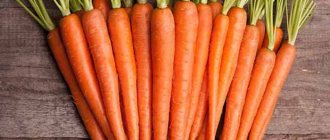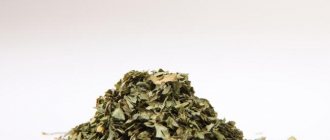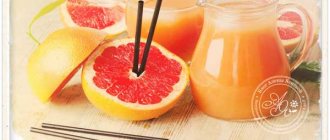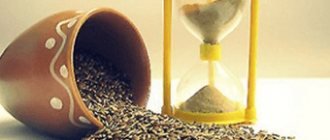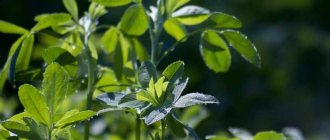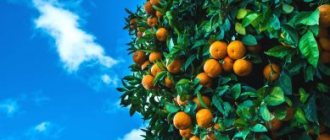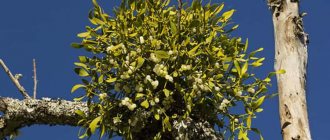Horsetail is a herbaceous plant that can be found almost anywhere in our homeland. The plant grows up to 70 cm in height and looks like a horse's tail, by the way, that's exactly how it is translated. Horsetail is not a poisonous plant and is used for medicinal purposes, however, certain types of horsetail contain toxic substances.
In the article we will tell you what diseases and ailments you can use the medicinal properties of horsetail for, how to use horsetail for weight loss, and whether there are contraindications and side effects.
Medicinal properties of the plant
Since ancient times, this representative of the flora has been used to treat various diseases. Horsetail has medicinal properties that will help not only for weight loss, but also in the following cases:
- The diuretic effect helps get rid of edema and gout. To treat these problems, the medicinal plant is used in the form of an infusion or decoction.
- Horsetail has disinfectant properties. It will help improve the condition of skin diseases, as well as dysentery. Extract is used.
- Horsetail is good for hypertension, as it lowers blood pressure. Used as an infusion or decoction.
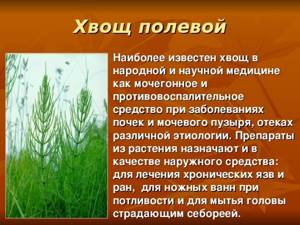
- The ancient plant has a pronounced anti-inflammatory effect. It can be used for pathologies of various organs: bladder, pharynx, bronchi, eyes. Inflammatory processes are treated with decoctions that can be taken orally or made into compresses.
- An extract of a medicinal plant is used to stop bleeding of various natures.
- Because horsetail has the ability to detoxify, it can be used to treat lead poisoning. The extract will free the body from this metal.
- Can be used for cosmetic purposes. Various baths and masks are made using horsetail to strengthen hair and nails.
- Decoctions and infusions are used for various stages of obesity, as they help normalize metabolism.
- Herbal tea from horsetail is good for diabetes.
We recommend reading the article about diuretic tea for weight loss. From it you will learn about the pros and cons of the drink, the effect on the body, rules of use for weight loss, and preparing a homemade drink. And here is more information about sage for weight loss.
Tea, rinses and baths

Horsetail has very wide uses. It can be used to make tea for both internal and external use (for poorly healing wounds). It is also recommended to use the decoction as a gargle for a sore throat. The bath is suitable for relieving spinal pain, problems with the prostate gland or intervertebral discs.
Useful properties for weight loss
Weight loss occurs due to two important properties of this plant. Horsetail is an excellent natural diuretic. Together with urine, it removes all excess fluid from the body, resulting in weight loss. Feeling a lack of water, the body begins to more actively break down accumulated fats.
In addition to the fact that all excess liquid leaves, harmful compounds and toxins leave the body along with it. Here, another ability of horsetail comes into play in the fight against extra pounds - improving metabolism. Cleansing itself of toxins, the body begins to work better, including absorbing beneficial components from food.
But you should be prepared for the fact that without additional effort, the lost weight will make itself felt again. For effective weight loss, it is not enough to get rid of fluid, which is what horsetail provides. These are the kilograms that return the fastest.
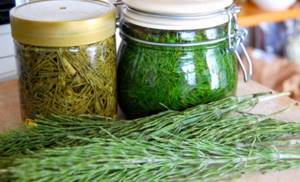
Nutritional value and composition
All the healing properties of horsetail are determined by the substances it contains. But at different stages of ripening, the characteristics of the plant differ.
For example, young spikelets that appear in the spring can be easily eaten. Based on them, various dietary dishes recommended by doctors for obesity are prepared. However, do not forget that the number of calories in young horsetail is not so small - 80 kcal per 100 grams of product. The ratio of proteins, fats and carbohydrates will please lovers of proper nutrition - 8%, 2% and 14%, respectively.
Young horsetail is not very suitable for weight loss. For these purposes, it is better to stick to green grassy shoots. They are formed on the plant by the beginning of the 2nd summer month. More mature horsetail begins to acquire its healing properties. Its composition amazes with a variety of useful elements:
- ascorbic acid, vitamin A;
- microelements such as calcium, manganese, potassium, iron;
- malic, oxalic, aconitic organic acids;
- vegetable styrene;
- natural antioxidants – flavonoids;
- macroelements: zinc, copper, boron, selenium, sulfur;
- tannins.
Also, a significant part of horsetail is occupied by silicon compounds - up to 10%. They have a beneficial effect on health: they accelerate metabolism, improve the condition of blood vessels and mucous membranes.
Expert opinion
Yulia Mikhailova
Nutrition expert
You should be careful when consuming horsetail. This plant, in addition to useful elements, contains toxic substances in small quantities. These include compounds: equisetonin, flavone glycosides.
For healthy hair
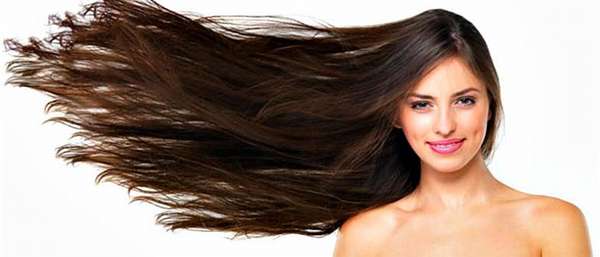
There are many shampoos, conditioners and other hair care products on the market that contain extracts from the medicinal plant. The hair extract can also be used at home by adding a few drops to your shampoo or conditioner. In addition, a herbal rinse or mask has healing properties for hair, which will restore shine and strength to it.
Hair decoction Horsetail decoction for hair is suitable for any skin type. 2-4 tsp. chopped dried herbs, pour 1/2 liter of boiled water (hot, but not boiling water). Leave for about 15-20 minutes. Then soak your hair in the broth and leave for half an hour. Wash your hair as usual.
Rinse with apple cider vinegar Mash fresh herbs (about 6-8 stems) in your hands and pour 1 liter of boiling water. Once cooled, add a spoonful of apple cider vinegar. Rinse your hair with the broth after washing and wrap your head in a towel for a quarter of an hour.
Possible harm and contraindications
Not everyone can use horsetail for weight loss. There are a number of absolute contraindications, in the presence of which the plant should be excluded from the diet:
- inflammatory processes in the kidneys, including nephritis, nephrosis;
- the use of medications aimed at reducing blood pressure or urine excretion;
- the period of bearing and feeding a child;
- uterine bleeding resulting from termination of pregnancy;
- childhood.
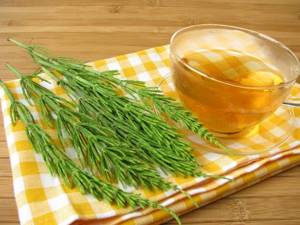
The medical community generally has a positive attitude towards the use of horsetail for weight loss and treatment. But doctors warn that independent use of this plant without prior consultation with a specialist can lead to complications such as:
- dehydration of the body;
- the occurrence of allergies;
- formation of salt stones in the kidneys.
To ensure that horsetail has only a beneficial effect, it is better to first talk to your doctor. He determines the individual dose. After all, if you abuse the plant, you can get poisoned, as it contains toxic substances.
Watch the video about the beneficial properties of horsetail:
For all occasions
For our grandmother Maklyura (PhD Valeria Sotnik), this inconspicuous-looking plant with light-brown stems that look like miniature Christmas trees 10–50 cm high is a valuable medicine.
In its diuretic, hemostatic and hypotensive properties, horsetail is in many ways superior to its green counterparts. Such a multifaceted effect of this plant is due to its rich chemical composition. It contains saponins, alkaloids, tannins, resins, bitterness, malic, aconitic, silicic and oxalic acids, vitamins C, B, carotene, flavonoids.
In folk medicine, horsetail herb has long been successfully used in the treatment of rheumatism, gout, liver and kidney diseases, bladder, pulmonary tuberculosis, and also as a hemostatic for hemorrhoids, uterine, pulmonary, nasal, intestinal and stomach bleeding. And tinctures from horsetail herb improve blood circulation during congestion that accompanies cardiovascular and pulmonary ailments (especially with exudative pleurisy). The healing plant is included in cosmetic creams, and its decoction is used in the form of rinses for stomatitis and other inflammatory processes of the oral mucosa and compresses for the treatment of seborrhea, wounds, boils, eczema, and fistulas.
How to brew horsetail for weight loss
To prepare a healing drink, it is enough to purchase the herb in dried form at the pharmacy. Various decoctions, infusions and teas for weight loss are created based on horsetail:
- Decoction. Take four tablespoons of horsetail and pour 200 ml of boiled, but not hot, water. The mixture is sent to a water bath for 30 minutes. In this case, it is better to cover it with a lid. After the specified time, remove the broth from the stove and cool. Squeeze the herb through cheesecloth until only liquid remains. You should get 200 ml of finished decoction. If there is not enough volume, add more boiled water. Take half a glass twice daily before meals.
- Tea. Horsetail can be brewed together with birch, which is also used for weight loss. You need to take both components in equal proportions and add hot water. Wait 10 minutes for the tea to prepare. Take the drink in the amount of half a glass 30 minutes before meals.
- Infusion. You need to take one teaspoon of dried horsetail and add a glass of hot boiled water to it. Leave for 2 hours. Take 15 ml of infusion 4 times a day.
- Decoction with other herbs. Horsetail, flaxseeds, nettle, buckthorn bark and meadowsweet are used to prepare this medicinal product. All ingredients are taken in equal quantities and poured with boiling water (one glass is enough). Heat for a quarter of an hour in a water bath. Then remove the pan and let the broth cool. Take one teaspoon orally every day an hour before meals.
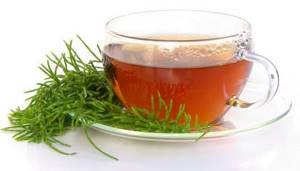
Horsetail tea for weight loss
Using horsetail at home
Folk herbalists have collected many time-tested recipes from horsetail. Some healers distinguish horsetail from a number of medicinal plants as an anti-inflammatory and expectorant for coughs. Others note the leading diuretic property of the herb. Still others recommend it as an external antiseptic.
Pharmacy drugs
What medications can you buy at the pharmacy?
- Liquid extract of horsetail. This drug is often used in cosmetology, for hair and facial skin care. It is also added to oil for anti-cellulite and lymphatic drainage massage.
- Horsetail in the composition of Marelin tablets. A well-known drug in urology, which is prescribed for urolithiasis. It has anti-inflammatory, antispasmodic properties, reduces pain during renal colic and stone removal. The drug received positive reviews from doctors. In addition to horsetail, it contains: extracts of goldenrod and madder, magnesium phosphate, salicylamide, kellin, korglykon. Repeated courses of treatment are usually prescribed to prevent urolithiasis.
- Herb in capsules. The capsules contain 400 mg of horsetail extract. Taken for swelling associated with renal and heart failure, as well as for cystitis and urethritis. In addition to its diuretic effect, the herb has antimicrobial and detoxifying properties. Capsules are prescribed to cleanse the blood and body of toxins, to improve metabolic processes, normal development of bone tissue, and rapid healing of bones after fractures.
- Horsetail grass. The instructions indicate the main pharmacological action - diuretic. It is sold in the form of crushed raw materials in packages of 50 or 100 g. The grass is also packaged in the form of filter bags or in the form of pressed briquettes.
- Homeopathic medicines. Another type of plant is widely used in homeopathy - wintering horsetail. Medicine is made from it in the form of granules and essences. Main indications for use: cystitis, urethritis, colic, stones, urinary incontinence, blood in the urine, difficulty excreting urine, uric acid diathesis.
Decoction
The decoction is primarily used as a diuretic for kidney and heart failure. More concentrated decoctions can be used externally as an antiseptic and anesthetic.
Preparation
- Take 1 tbsp. l. dry raw materials.
- Pour a glass of boiling water.
- Boil for 1 minute.
- Leave for 30 minutes.
- Strain.
- Take 3 tbsp. l. dry raw materials.
- Pour in 2 cups of cold water.
- Insist for a day.
- Strain.
- Take 1 tbsp. l. raw materials.
- Pour a glass of boiling water.
- Leave for 30 minutes.
- Strain.
- Mix 10 g each of horsetail, linden blossom, plantain, mallow flowers and 5 g each of thyme, elderberry and fennel.
- Take 2 tsp. mixtures of herbs.
- Pour a glass of boiling water.
- Leave for 15 minutes.
- Strain.
- Take 20 g of herb.
- Pour in a liter of white wine.
- Insist for a week.
- Strain.
- Take 1 part of the powdered raw material.
- Add 4 parts fat (pork, goose, butter, Vaseline).
- Stir.
- Horsetail for hair. Herbal decoctions prevent hair loss, accelerate hair growth, strengthen hair follicles and structure, prevent the development of seborrhea, fungal diseases, and the formation of dandruff. To obtain a therapeutic effect, rinse your hair with herbs after each hair wash for a month. Masks are also made from decoctions and infusions, which are rubbed into the scalp.
- For facial skin. In cosmetology, the herb is valued for its anti-aging properties. It stimulates collagen biosynthesis and metabolism, ensures the strength of connective tissue, and smoothes out fine wrinkles. That is why horsetail extract is so often included in anti-aging cosmetics. Lotions and tonics from infusions are used to wipe acne, suppuration on the skin, and inflamed acne. The herb relieves irritation well, eliminates excess oil, so it is suitable not only for mature, but also young skin.
This decoction relieves swelling well. It is taken 1 tbsp. l. 4 times a day in repeated courses. Let us emphasize once again: it is important to consult a doctor before taking the decoction to rule out nephritis and nephrosis (for these diagnoses, the herb is strictly contraindicated).
Infusion
The infusion is indicated for all the diagnoses mentioned above. It can be prepared cold or hot.
Preparation of cold infusion
This infusion is recommended to be added to medicinal baths for skin diseases, rheumatic and joint pain. The infusion is also used for compresses, rinsing, and lotions.
Preparation of hot infusion
This infusion can be taken orally in the same dosage as the decoction. It is also used externally.
Tea
The famous German herbalist and pharmacist Mannfried Palou recommends drinking horsetail tea for respiratory diseases, as well as for their prevention. You can prepare a drink only from horsetail (take 1 cup of boiling water for 2 teaspoons). But it is better to drink the herb together with other medicinal plants.
Preparation
This is an effective cough remedy and strengthens the immune system. You can drink 2 cups a day during flu and ARVI epidemics for prevention.
Alcohol tincture
Most often, the tincture is made with wine. It is shown as a general tonic, cleanses the blood, restores blood circulation, and improves metabolism. It is also recommended for complex treatment of tumors of the digestive organs.
Preparation
Take 2 tablespoons on an empty stomach for several weeks. It especially helps with internal bleeding. There are many positive reviews about horsetail as a hemostatic medicine. However, it is best to use fresh plant juice to stop bleeding.
Ointment
It is used as an external antiseptic and wound healing agent.
Preparation
This mixture is used to lubricate purulent wounds, ulcers, and cracks.
Cosmetology
Features of use in women, men, children
- For women. The herb is most often prescribed in a medicinal mixture to stop uterine bleeding. Horsetail is also prescribed during pregnancy, especially in the last trimester for edema. However, the use of the herb in pregnant women is recommended only after consultation with a doctor. Nursing mothers can treat cracked nipples with decoctions.
- For men. The herb is most often used in hair care, to prevent baldness and strengthen hair. In combination with other herbs, horsetail stimulates sexual activity, increases potency, and treats inflammatory processes in the genitourinary organs.
- For children. It is important to remember that in young children, the use of diuretics can lead to the risk of dehydration, leaching of trace elements and other beneficial substances from the body. Long-term internal use of horsetail-based medications should be under the supervision of a physician. External use does not cause any concern if there is no allergy to grass. The use of horsetail for adenoids in children and the treatment of cough also require medical supervision. The herb is not recommended for children under 3 years of age.
The main use of horsetail is for diseases of the urinary system, respiratory and digestive organs. It is an effective diuretic, antispasmodic, and detoxifying agent. Heals wounds well, helps with rheumatic and gouty pain, stimulates metabolism and the functioning of blood vessels, cleanses the blood, stops bleeding.
How to drink for weight loss
For weight loss, horsetail can be used in various forms. But it should be remembered that infusions, decoctions and teas based on this plant can only be taken for 2-3 weeks. This is due to the fact that horsetail quickly removes fluid, and if consumed uncontrolled, this can lead to dehydration.
Therefore, after 3 weeks you should take a short break. You can repeat the course in a couple of months. Then you will be able to maintain good health and well-being.
But during the course, which lasts no more than one month, you need to drink infusions and decoctions of horsetail for weight loss every day. Only then will you be able to lose a few extra pounds.
From horsetail, chamomile and mint
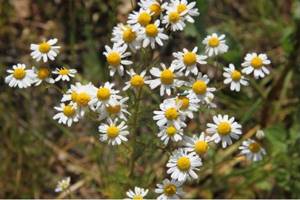
This recipe will be a good antimicrobial and anti-inflammatory agent. It will quickly relieve the discomfort caused by the adenoids and return the tonsils to their normal size.
Compound
- chamomile, mint, horsetail 0.5 tsp each;
- water 250 ml.
Preparation
- Pour mixed herbs with water.
- Boil for 5 minutes.
- Leave for 25-30 minutes.
- To achieve maximum effect, you need to drink tea from horsetail, mint and chamomile three times a day for 2 weeks.
